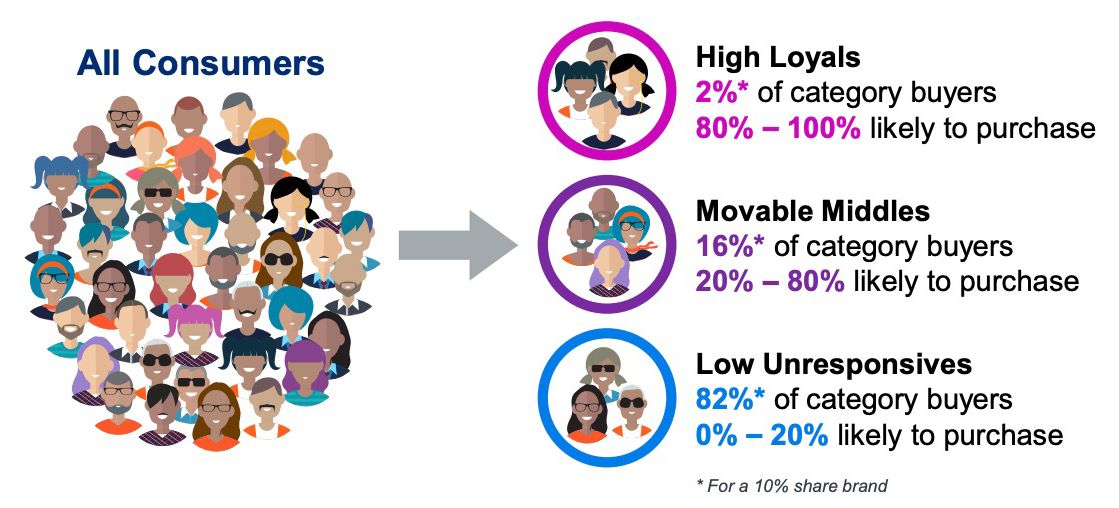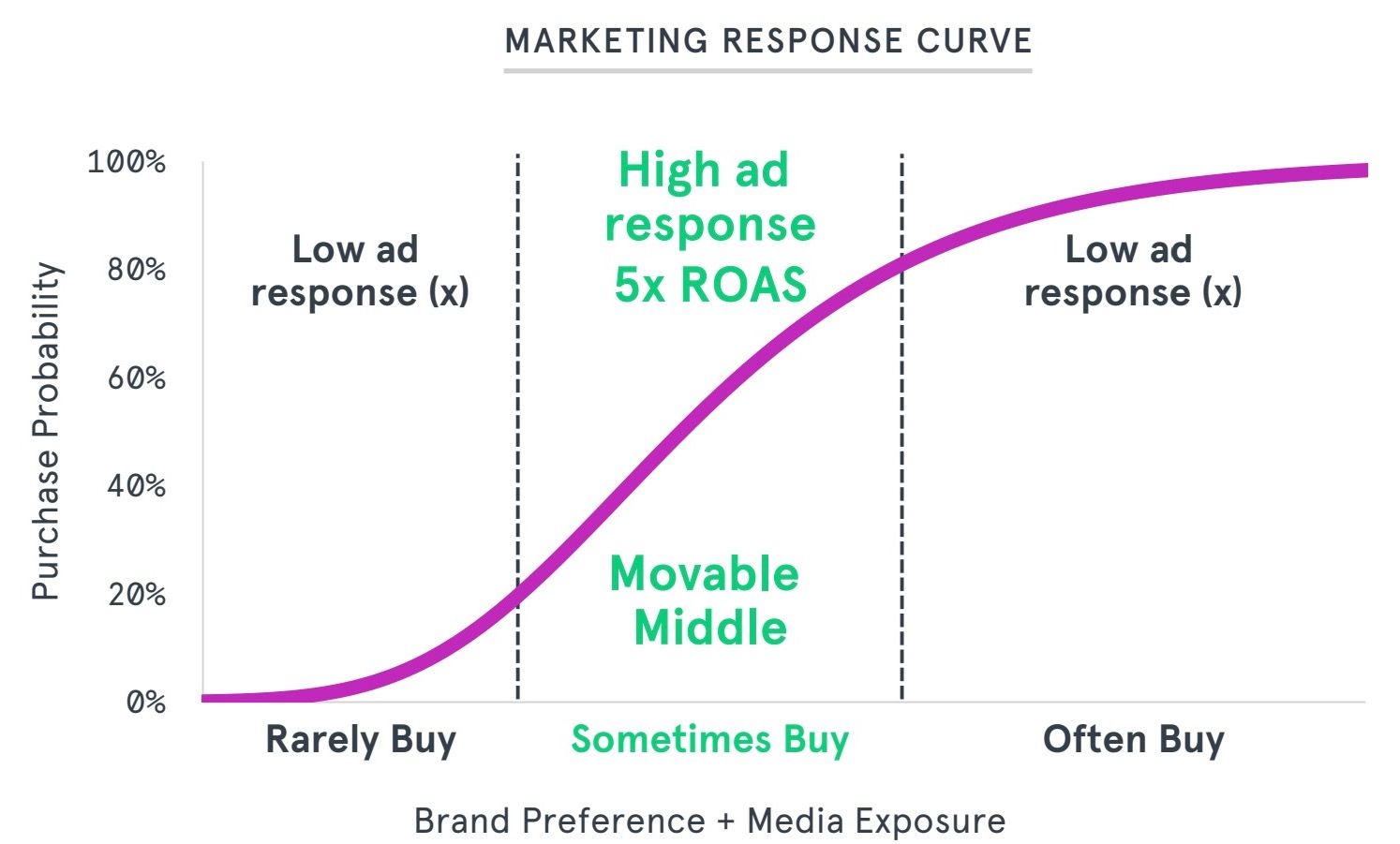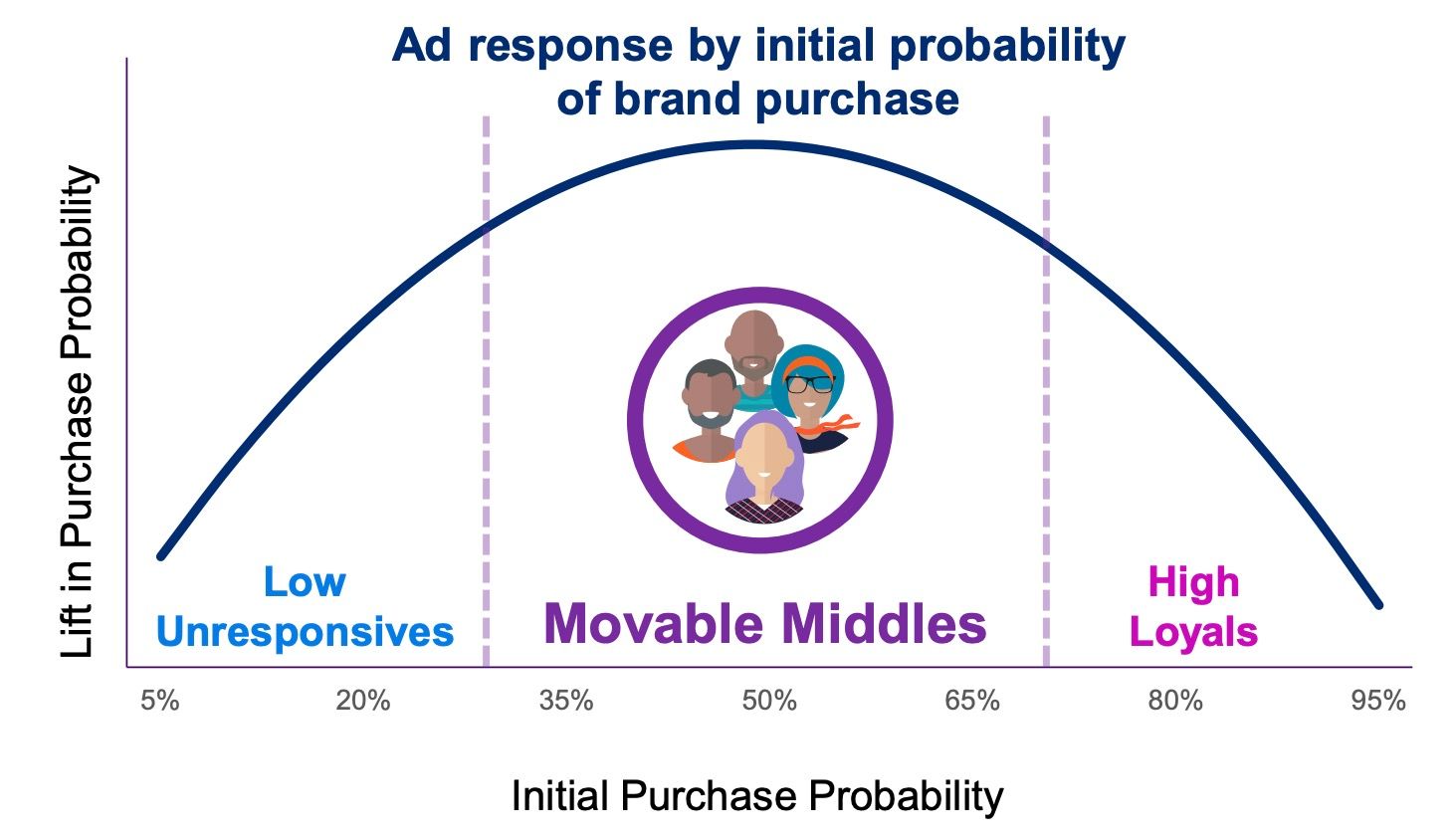Guide: Implementing Movable Middles Growth Framework with AI
Movable Middles Growth Framework (MMGF) represents the next evolution of customer-centric marketing. It's a new framework, developed by the MMA and Neustar, designed to drive profitable growth by targeting specific consumer segments known as the 'movable middle'. Unlike marketing methods that cast a wide net, such as traditional reach plans, MMGF focuses on efficiently targeting consumers who are most likely to be influenced by marketing efforts and aren’t already loyal customers.
The Concept of Movable Middles and Their Importance
- Efficient Use of Budget: Minimizing waste by focusing on potential customers who can be swayed.
- Higher Conversion Rates: Creating tailored strategies that resonate with movable middles.
- Scalable Growth: Applying this concept across various campaigns and demographics for sustained growth.
Movable Middles Growth Framework
MMGF uses AI and analytics to pinpoint segments rich in movable middles and understand their unique characteristics and behaviors. This involves:
- Segmentation: Breaking down the market and focusing on segments rich in movable middles.
- Personalization: Creating tailored messages and offers to engage this segment.
- Measurement and Optimization: Continuously tracking performance and optimizing strategies.
Why Targeting Movable Middles is Effective
- Efficient Use of Budget: Concentrating marketing spend on this segment ensures higher ROI. This targeted approach minimizes wasted ad spend on those who are already committed to a brand or those completely uninterested.
- Higher Conversion Rates: Tailoring strategies specifically to movable middles involves understanding their preferences, needs, and pain points. Brands can drive higher engagement by crafting messages, offers, and experiences that resonate with these segments.
- Scalable Growth: The concept of targeting movable middles is not limited to a single campaign or product; it's a repeatable and scalable strategy. Brands can apply the same principles across different campaigns, products, or markets by continuously identifying, understanding, and engaging this segment.
Benefits and Challenges
- Benefits: Enhanced ROAS, increased conversion rates, personalized customer experiences.
- Challenges: Requires sophisticated data analytics and understanding of consumer behavior.
The Role of AI in Modern Marketing Strategies
The challenges of MMGF, particularly the need for sophisticated data analytics and an intricate understanding of consumer behavior, are precisely where AI shines. AI can simplify the implementation of MMGF, making it accessible to most marketers.
The movable middles can be identified via modeling and targeted via segmentation. Traditionally, this process required advanced data science skills. But with AI tools, marketers can do this themselves. AI democratizes access to insights and analytics, making the once daunting task of pinpointing and engaging movable middles feasible for marketing teams.
AI is a valuable tool in executing the MMGF framework. It enhances the effectiveness of targeting the movable middles and scales the process, enabling a broader application. Through intelligent targeting, analytics, and ad optimization, AI enables marketers to reach movable middles with precision and scale.
AI-Driven Techniques for Identifying and Engaging Movable Middles
- Content Personalization: Creating relevant and engaging content that resonates with movable middles is crucial for effective engagement. This involves understanding their unique preferences, needs, and values, and then crafting content that speaks directly to them. AI plays a vital role here by enabling dynamic content personalization. By analyzing individual interactions and behaviors, AI can create or recommend content that is highly relevant to each Movable Middle, enhancing their experience and affinity towards the brand.
- Performance Tracking: Performance tracking is essential for continuous improvement, and using AI to measure and optimize performance adds a layer of precision and responsiveness. AI can analyze real-time data to monitor how well strategies are resonating with movable middles. It can also autonomously make adjustments to strategies, such as tweaking ad placements, to ensure that performance targets are met.
- Targeting and Analytics: AI can sift through vast amounts of data to identify the unique characteristics and behaviors of movable middles. This includes analyzing past purchasing behaviors, social media interactions, online browsing habits, and more.
Advertising and AI: Targeting Movable Middles with Precision
Programmatic Advertising and AI's Role
Programmatic advertising accounts for an estimated 91% of US digital display advertising in 2023 (source). AI makes most of this possible by automating the real-time buying and selling of digital ads. By leveraging AI-powered technology, advertisers can reach the right people at the right moments for a fraction of the traditional cost.
How AI Advertising Enhances MMGF
- Ad Creation and Optimization: AI's ability to generate hundreds of ad variations using Natural Language Processing (NLP) and Natural Language Generation (NLG) is vital for crafting messages that resonate with segments of movable middles. This goes beyond basic templates; AI algorithms can understand historical data, learn from past successful ads, and dynamically create content that resonates with different audience segments. AI is not only useful at producing ads; it can fine-tune them at scale through audience optimization and creative optimization, achieving a hierarchical approach to advertising. By understanding customer behavior and preferences, it enables the creation of highly targeted and personalized content, leading to better engagement and conversion rates.
- Predicting Ad Performance: AI’s predictive analytics evaluates various creative elements across millions of existing ads to predict which combinations of text and images will work best. By simulating various ad variations and measuring them against known performance metrics, AI provides marketers with a data-backed chance of success before even launching a campaign. This predictive capability ensures optimal return on ad spend (ROAS) by targeting only non-buyers and light-buyers who are most likely to be influenced.
- Optimizing Budgets and Targeting: AI can autonomously manage complex tasks such as budget allocation and audience targeting, continuously analyzing real-time data to enhance strategies for reaching movable middles. Precision targeting is paramount in modern marketing, especially when focusing on segments defined by their probability of buying a brand. AI's ability to analyze vast amounts of data and segment audiences allows marketers to target these key segments with extraordinary accuracy. The result is more effective campaigns and a higher ROAS.
Analytics and AI: Understanding Movable Middles Through Intelligent Insights
AI-powered analytics leverage machine learning to analyze large datasets, providing insights at speed and scale. In the era of digital marketing, the sheer volume of data can be overwhelming. AI steps in to extract valuable insights, often predicting future patterns and offering prescriptive solutions.
How AI Analytics Enhances MMGF
- Discovering Insights: AI's ability to detect patterns, uncover insights, and unify data from various first- and third-party sources is transformative. From social media sentiment analysis to competitive intelligence, AI analytics offers a comprehensive view of the market landscapes, customer opinions, and emerging trends. By transforming raw information into actionable intelligence, AI provides a deep understanding that is vital for targeting movable middles.
- Performance and Real-Time Analytics: AI's real-time tracking and measurement capabilities provide a granular view of ad campaigns' effectiveness. From click-through rates to engagement metrics, AI analytics helps marketers continuously refine their strategies, ensuring that the campaigns resonate across all buyer segments.
- Predictive and Prescriptive Analytics: AI takes analytics to the next level by forecasting future outcomes and autonomously deciding actions. By applying machine learning to historical data, AI can anticipate market trends, pricing changes, and consumer interests. This forward-looking approach, coupled with prescriptive analytics that determines the best course of action, equips marketers with foresight and adaptability.
Vendors to Explore
Navigating the dynamic terrain of AI-driven marketing can be complex, especially when faced with the challenge of discerning authentic innovation from exaggerated claims. As a marketing executive, I've sifted through many vendors boasting advanced AI capabilities. Drawing from my career and research, I have identified the following vendors as trustworthy and capable of delivering on their promises.
Vendors offering AI advertising solutions:
- Albert automates and optimizes paid advertising campaigns across various platforms, covering about 90% of the biddable universe.
- Celtra automates the production of personalized marketing variants with intelligent features such as automated layouts and smart image cropping.
- Omneky uses OpenAI's models to automate visual and text creation for social ads, tailoring content to a brand’s identity.
- Pattern89 predicts Facebook and Instagram ad performance, offering data-backed design recommendations.
- Persado Persado employs AI to craft messaging for ads and customer interactions, enhancing conversion and engagement.
Vendors offering AI analytics solutions:
- Adobe Analytics analyzes and visualizes insights from large online and offline datasets.
- Attention Insight utilizes AI to predict the performance of design elements across ads, landing pages, and apps.
- BlueConic is a customer data platform that unifies first-party data for person-level marketing profiles, offering insights, customer scoring, and segmentation.
- Clickvoyant automates analytics reporting, enhancing strategic decision-making by quickly extracting insights and creating presentations.
- Crayon offers market intelligence through AI, tracking over one hundred data types from millions of sources.
- Google Analytics is a widely used platform that leverages Google's machine learning for insightful data analytics. The latest version includes natural language responses, smart goals, and conversion probability.
- Helixa combines AI, machine learning, and big data to produce detailed audience personas.
- Invoca is an AI-driven call tracking and analytics platform that connects call center sales to marketing activities.
- Mobilewalla enriches predictive models with third-party consumer data, aggregating vast information volumes.
Conclusion
Artificial Intelligence is more than a supplementary technology in the Movable Middles Growth Framework—it's a catalyst that propels marketing efforts into a new era of precision and relevance. Under the guidance of a mathematically validated framework, AI unveils pathways to customer engagement that were previously unattainable.
Practical Tips and Insights for Implementation
Focus on the Movable Middles:
- Identify with Predictive Modeling: Use historical data and AI-driven segmentation to target persuadable customers, which resulted in 4.8X greater ROAS for one brand in the MMA study.
- Engage through Dynamic Personalization: Implement AI tools for tailored content that resonates with the movable middles, attracting more open-minded non-buyers.
- Optimize with Outcome-Based Plans: Utilize outcome-based strategies to outperform traditional reach plans by over 50% on ROAS, reaching more consumers.
- Capitalize on the Movable Middles' Size: Recognize the large size and impact of movable middles when compared to heavy buyers, giving marketers a much larger target to work with.
Utilize AI-powered Tools and Strategies:
- Use Segmentation Tools: Implement AI-powered segmentation tools to accurately identify and target segments with the largest concentration of movable middles.
- Optimize Creativity Through AI: Employ AI's creative capabilities to produce personalized and resonant content.
- Implement Dynamic Personalization: Utilize machine learning for real-time engagement and AI-driven programmatic ad placement for efficiency and customization.
Invest in Analytics and Performance Management:
- Monitor and Adjust Campaigns: Use real-time analytics tools to regularly review and adjust strategies based on performance metrics.
- Predict and Adapt: Utilize predictive analytics for data-driven insights and prescriptive analytics to automatically adapt strategies.
By embracing AI's full potential, marketing leaders can redefine the landscape, targeting those most susceptible to influence and driving growth like never before.






